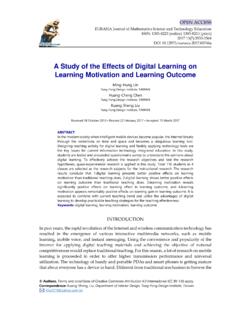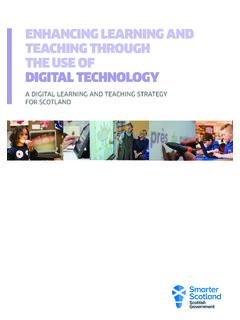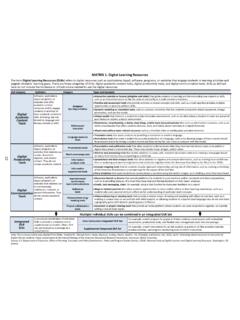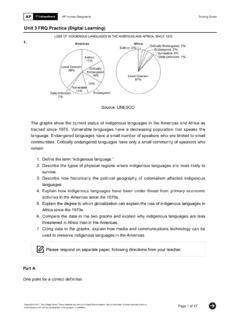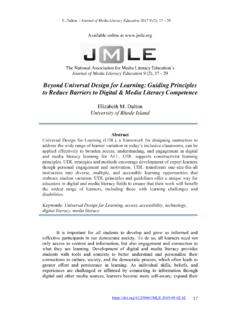Transcription of Connectivism: A Learning Theory for the Digital Age
1 Jan05_01 Jan 2005 Index Home Page Editor's Note: This is a milestone article that deserves careful study. connectivism should not be con fused with constructivism. George Siemens advances a Theory of Learning that is consistent with the needs of the twenty first century. His Theory takes into account trends in Learning , the use of technology and networks, and the diminishing half-life of knowledge. It combines relevant elements of many Learning theories, social structures, and technology to create a powerful theoretical construct for Learning in the Digital age. connectivism : A Learning Theory for the Digital Age George Siemens Introduction Behaviorism, cognitivism, and constructivism are the three broad Learning theories most often utilized in the creation of instructional environments.
2 These theories, however, were developed in a time when Learning was not impacted through technology. Over the last twenty years, technology has reorganized how we live, how we communicate, and how we learn. Learning needs and theories that describe Learning principles and processes, should be reflective of underlying social environments. Vaill emphasizes that Learning must be a way of being an ongoing set of attitudes and actions by individuals and groups that they employ to try to keep abreast of the surprising, novel, messy, obtrusive, recurring events (1996, ). Learners as little as forty years ago would complete the required schooling and enter a career that would often last a lifetime. Information development was slow. The life of knowledge was measured in decades. Today, these foundational principles have been altered.
3 Knowledge is growing exponentially. In many fields the life of knowledge is now measured in months and years. Gonzalez (2004) describes the challenges of rapidly diminishing knowledge life: One of the most persuasive factors is the shrinking half-life of knowledge. The half-life of knowledge is the time span from when knowledge is gained to when it becomes obsolete. Half of what is known today was not known 10 years ago. The amount of knowledge in the world has doubled in the past 10 years and is doubling every 18 months according to the American Society of Training and Documentation (ASTD). To combat the shrinking half-life of knowledge, organizations have been forced to develop new methods of deploying instruction.. Some significant trends in Learning : Many learners will move into a variety of different, possibly unrelated fields over the course of their lifetime.
4 Informal Learning is a significant aspect of our Learning experience. Formal education no longer comprises the majority of our Learning . Learning now occurs in a variety of ways through communities of practice, personal networks, and through completion of work-related tasks. Learning is a continual process, lasting for a lifetime. Learning and work related 1 of 9 6/6/08 5:56 PM. Jan05_01 activities are no longer separate. In many situations, they are the same. Technology is altering (rewiring) our brains. The tools we use define and shape our thinking. The organization and the individual are both Learning organisms. Increased attention to knowledge management highlights the need for a Theory that attempts to explain the link between individual and organizational Learning . Many of the processes previously handled by Learning theories (especially in cognitive information processing) can now be off-loaded to, or supported by, technology.
5 Know-how and know-what is being supplemented with know-where (the understanding of where to find knowledge needed). Background Driscoll (2000) defines Learning as a persisting change in human performance or performance potential [which] must come about as a result of the learner's experience and interaction with the world ( ). This definition encompasses many of the attributes commonly associated with behaviorism, cognitivism, and constructivism . namely, Learning as a lasting changed state (emotional, mental, physiological ( skills)) brought about as a result of experiences and interactions with content or other people. Driscoll (2000, p14-17) explores some of the complexities of defining Learning . Debate centers on: Valid sources of knowledge - Do we gain knowledge through experiences?
6 Is it innate (present at birth)? Do we acquire it through thinking and reasoning? Content of knowledge Is knowledge actually knowable? Is it directly knowable through human experience? The final consideration focuses on three epistemological traditions in relation to Learning : Objectivism, Pragmatism, and Interpretivism Objectivism (similar to behaviorism) states that reality is external and is objective, and knowledge is gained through experiences. Pragmatism (similar to cognitivism) states that reality is interpreted, and knowledge is negotiated through experience and thinking. Interpretivism (similar to constructivism) states that reality is internal, and knowledge is constructed. All of these Learning theories hold the notion that knowledge is an objective (or a state). that is attainable (if not already innate) through either reasoning or experiences.
7 Behaviorism, cognitivism, and constructivism (built on the epistemological traditions). attempt to address how it is that a person learns. Behaviorism states that Learning is largely unknowable, that is, we can't possibly understand what goes on inside a person (the black box Theory ). Gredler (2001). expresses behaviorism as being comprised of several theories that make three 2 of 9 6/6/08 5:56 PM. Jan05_01 assumptions about Learning : 1. Observable behaviour is more important than understanding internal activities 2. Behaviour should be focused on simple elements: specific stimuli and responses 3. Learning is about behaviour change Cognitivism often takes a computer information processing model. Learning is viewed as a process of inputs, managed in short term memory, and coded for long-term recall.
8 Cindy Buell details this process: In cognitive theories, knowledge is viewed as symbolic mental constructs in the learner's mind, and the Learning process is the means by which these symbolic representations are committed to memory.. Constructivism suggests that learners create knowledge as they attempt to understand their experiences (Driscoll, 2000, p. 376). Behaviorism and cognitivism view knowledge as external to the learner and the Learning process as the act of internalizing knowledge. Constructivism assumes that learners are not empty vessels to be filled with knowledge. Instead, learners are actively attempting to create meaning. Learners often select and pursue their own Learning . Constructivist principles acknowledge that real-life Learning is messy and complex. Classrooms which emulate the fuzziness of this Learning will be more effective in preparing learners for life-long Learning .
9 Limitations of Behaviorism, Cognitivism, and Constructivism A central tenet of most Learning theories is that Learning occurs inside a person. Even social constructivist views, which hold that Learning is a socially enacted process, promotes the principality of the individual (and her/his physical presence brain- based) in Learning . These theories do not address Learning that occurs outside of people ( Learning that is stored and manipulated by technology). They also fail to describe how Learning happens within organizations Learning theories are concerned with the actual process of Learning , not with the value of what is being learned. In a networked world, the very manner of information that we acquire is worth exploring. The need to evaluate the worthiness of Learning something is a meta-skill that is applied before Learning itself begins.
10 When knowledge is subject to paucity, the process of assessing worthiness is assumed to be intrinsic to Learning . When knowledge is abundant, the rapid evaluation of knowledge is important. Additional concerns arise from the rapid increase in information. In today's environment, action is often needed without personal Learning that is, we need to act by drawing information outside of our primary knowledge. The ability to synthesize and recognize connections and patterns is a valuable skill. Many important questions are raised when established Learning theories are seen through technology. The natural attempt of theorists is to continue to revise and evolve theories as conditions change. At some point, however, the underlying conditions have altered so significantly, that further modification is no longer sensible.
